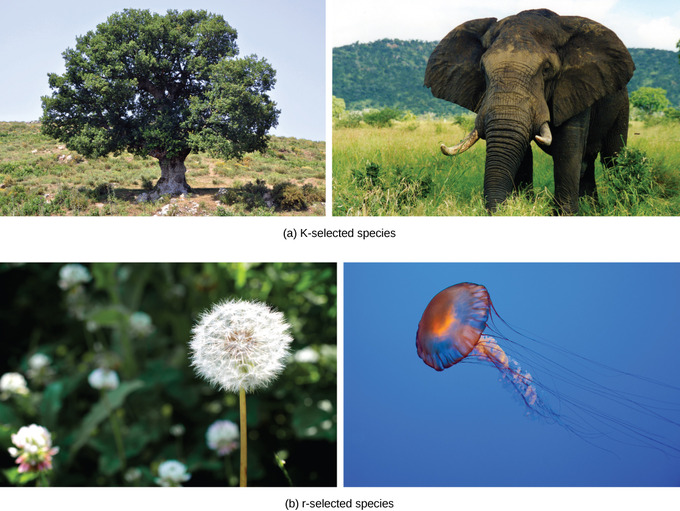109 Life History Evolution
By the end of this section, you will be able to:
- Distinguish between K- and r-selected species
Modern theories of life history incorporate life and survivorship factors with ecological concepts associated with r- and K-selection theories.
Early theories about life history: K-selected and r-selected species
While reproductive strategies play a key role in life histories, they do not account for important factors such as limited resources and competition. The regulation of population growth by these factors can be used to introduce a classical concept in population biology: that of K-selected versus r-selected species.
By the second half of the twentieth century, the concept of K- and r-selected species was used extensively and successfully to study populations. The concept relates not only to reproductive strategies, but also to a species’ habitat and behavior. This includes the way they obtain resources and care for their young, as well as length of life and survivorship factors. For this analysis, population biologists have grouped species into the two large categories, K-selected and r-selected, although they are really two ends of a continuum. The first variable is K (the carrying capacity of a population; density dependent), and the second variable is r (the intrinsic rate of natural increase in population size, density independent).
K-selected species
K-selected species are those in stable, predictable environments. Populations of K-selected species tend to exist close to their carrying capacity (hence the term K-selected) where intraspecific competition is high. These species produce few offspring, have a long gestation period, and often give long-term care to their offspring. While larger in size when born, the offspring are relatively helpless and immature at birth. By the time they reach adulthood, they must develop skills to compete for natural resources. Examples of K-selected species are primates including humans, other mammals such as elephants, and plants such as oak trees.

In plants, scientists think of parental care more broadly: how long fruit takes to develop or how long it remains on the plant are determining factors in the time to the next reproductive event. Oak trees grow very slowly and take, on average, 20 years to produce their first seeds, known as acorns. As many as 50,000 acorns can be produced by an individual tree, but the germination rate is low as many of these rot or are eaten by animals such as squirrels. In some years, oaks may produce an exceptionally large number of acorns; these years may be on a two- or three-year cycle depending on the species of oak (r-selection).
As oak trees grow to a large size (and for many years before they begin to produce acorns) they devote a large percentage of their energy budget to growth and maintenance. The tree’s height and size allow it to dominate other plants in the competition for sunlight, the oak’s primary energy resource. Furthermore, when it does reproduce, the oak produces large, energy-rich seeds that use their energy reserve to become quickly established (K-selection).
r-selected species
In contrast to K-selected species, r-selected species have a large number of small offspring (hence their r designation). This strategy is often employed in unpredictable or changing environments. Animals that are r-selected do not give long-term parental care and the offspring are relatively mature and self-sufficient at birth. Examples of r-selected species are marine invertebrates, such as jellyfish, and plants, such as the dandelion. Dandelions have small seeds that are dispersed long distances by wind; many seeds are produced simultaneously to ensure that at least some of them reach a hospitable environment. Seeds that land in inhospitable environments have little chance for survival since the seeds are low in energy content. Note that survival is not necessarily a function of energy stored in the seed itself.
Modern theories of life history
The r- and K-selection theory, although accepted for decades and used for much groundbreaking research, has now been reconsidered. Many population biologists have abandoned or modified it. Over the years, several studies attempted to confirm the theory, but these attempts have largely failed. Many species were identified that did not follow the theory’s predictions. Furthermore, the theory ignored the age-specific mortality of the populations which scientists now know is very important. New demographic-based models of life history evolution have been developed which incorporate many ecological concepts included in r- and K-selection theory, as well as population age structure and mortality factors.
Glossary
carrying capacity
the number of individuals of a particular species that an environment can support; indicated by the letter “K”
intraspecific
occurring among members of the same species
This chapter by Boundless is licensed CC BY-NC-SA 3.0.

